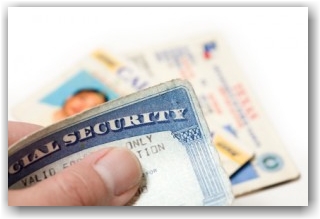Posts Tagged ‘Department Of Homeland Security (DHS)’
Wednesday, May 7th, 2014

Under existing regulations, DHS does not extend employment authorization to dependents (also known as H-4 nonimmigrants) of H-1B nonimmigrant workers. The change proposed by DHS, would allow H-4 dependent spouses of certain H-1B nonimmigrant workers to request employment authorization, as long as the H-1B worker has already started the process of seeking lawful permanent residence through employment.
Eligible individuals would include H-4 dependent spouses of principal H-1B workers who:
- Are the beneficiaries of an approved Form I-140, Immigrant Petition for Alien Worker; or
- Have been granted an extension of their authorized period of stay in the United States under the American Competitiveness in the Twenty-first Century Act of 2000 (AC21) as amended by the 21st Century Department of Justice Appropriations Authorization Act. AC21 permits H-1B workers seeking lawful permanent residence to work and remain in the United States beyond the six-year limit. Refer to AC 21 12/27/2005 Aytes Memo for details.
Proposal to Enhance Opportunities for Highly-Skilled Workers: H-1B1 (Chile and Singapore) and E-3
Specifically, the change to the regulation would:
- Update the regulations to include nonimmigrant high-skilled specialty occupation professionals from Chile and Singapore (H-1B1) and from Australia (E-3) in the list of classes of aliens authorized for employment incident to status with a specific employer.
- Clarify that H-1B1 and principal E-3 nonimmigrants are allowed to work without having to separately apply to DHS for employment authorization. Under current regulations, employers of workers in E-3, H-1B1, or CW-1 status must generally file a petition requesting the extension of the employee’s status well before the initial authorized duration of status expires.
- Allow E-3, H-1B1 and CW-1 nonimmigrant workers up to 240 days of continued work authorization beyond the expiration date noted on their Form I-94, Arrival/Departure Record, while the extension request is pending.
It would affect workers in specialty occupation nonimmigrant classifications for professionals from Chile and Singapore (H-1B1) and Australia (E-3), as well as Commonwealth of the Northern Mariana Island (CNMI)-Only Transitional Workers (CW-1).
Finally, this proposal would also expand the current list of evidentiary criteria for employment-based first preference (EB-1) outstanding professors and researchers to allow the submission of evidence comparable to the other forms of evidence already listed in the regulations. This proposal would harmonize the regulations for EB-1 outstanding professors and researchers with other employment-based immigrant categories that already allow for submission of comparable evidence.
Both Notices of Proposed Rulemaking will soon publish in the Federal Register. DHS encourages the public to comment on the proposed rules through www.regulations.gov. All public comments will be considered before the final rules are published and go into effect. We will keep you posted on next steps when this actually becomes effective.
The DHS Press Release
Tags: AC21, Department Of Homeland Security (DHS), DOL, E-3 Spouse Work Authorization, eb-1, eb-2, eb-3, H-1B Specialty Workers, H-1B1 Spouse Work Authorization, H-4 Work Authorization, Immigrant Visas (I-140 Petitions), Immigration News, PERM Labor Certification, USCIS
Posted in Department Of Homeland Security (DHS), Department Of Labor (DOL), H-1B Visas, Immigrant Visas (I-140 Petitions), Immigration News, USCIS | Comments Off on DHS Announces Proposed Rulemaking for H-4 Spouse Work Authorization
Wednesday, January 15th, 2014
 There are certain classes of non-profit employers who are exempt from the H-1B cap. The exemption from the cap only applies to institutions of higher education, non-profit research institutions, government research institutions, and non-profits formally affiliated with an exempt educational institution. Let’s discuss this.
There are certain classes of non-profit employers who are exempt from the H-1B cap. The exemption from the cap only applies to institutions of higher education, non-profit research institutions, government research institutions, and non-profits formally affiliated with an exempt educational institution. Let’s discuss this.
Institutions of higher education: Under the definition, an institution of higher education is one which:
- admits students who have completed secondary education;
- is licensed to provide education beyond secondary school;
- provides educational programs for which the institutions award bachelors’ degrees or provide programs of not less than 2 years that are acceptable for full credit toward bachelors’ degrees;
- is a public or nonprofit institution; and
- is accredited or has been granted pre-accreditation status by a recognized accrediting agency.
What does it mean to be related or affiliated to a higher education institution nonprofit entity?
The USCIS states that it is sufficient that a nonprofit entity is related or affiliated to an institution of higher education through shared ownership, control or be somehow affiliated to the higher education institution as a member, branch or subsidiary.
This narrow definition makes the types of non-profits that qualify for this exemption few and far between. For instance, non-profit service, community, policy and arts organizations would not qualify for the exemption from the H-1B cap. Unless the non-profit employer is primarily devoted to research, or is formally affiliated with a university, it will not qualify as a cap-exempt H1B petitioner. Public secondary schools do not qualify for H1B cap-exemption unless they have a formal affiliation agreement with a college or university. However, the exemption does cover certain professionals employed by a for-profit entity but but does when working at an exempt location, as long as the work continues to serve the core mission of the exempt institution, such as a physicians’ practice group affiliated with and located at a university teaching hospital.
Nonprofit Research Organizations | Government Research Organizations: Nonprofit research organizations or governmental research organizations, are defined in 8 CFR 214.2(h)(19)(iii)(C), as follows:
- A nonprofit research organization is an organization that is primarily engaged in basic research and/or applied research.
- A governmental research organization is a United States Government entity whose primary mission is the performance or promotion of basic research and/or applied research.
Basic research is general research to gain more comprehensive knowledge or understanding of the subject under study, without specific applications in mind. Basic research is also research that advances scientific knowledge, but does not have specific immediate commercial objectives although it may be in fields of present or potential commercial interest. It may include research and investigation in the sciences, social sciences, or humanities.
Applied research is research to gain knowledge or understanding to determine the means by which a specific, recognized need may be met. Applied research includes investigations oriented to discovering new scientific knowledge that has specific commercial objectives with respect to products, processes, or services. It may include research and investigation in the sciences, social sciences, or humanities.
Conclusion
It should be noted that all of the criteria above must be met in order for an institution or an organization to qualify for a cap-exempt status for H-1B purposes. Such institutions and organizations can indicate that their H1B filing is cap exempt by marking Form I-129 (Petition of Non-Immigrant Worker) with a “yes” answer to questions 1, 2, or 3 in Part C of the H1B Data Collection and Filing Fee Exemption Supplement. Bear in mind that an employer or a foreign national who wishes to seek H-1B status under a cap-exempt petition must verify that they qualify for the cap exemption under one of the three categories above. It is recommended that you work with an immigration practitioner that understands this casework as the analysis is often complex. If you’d like to become a client of our office, please contact us at info@immigrationcompliancegroup.com or call 562 612-3996.
Tags: Department Of Homeland Security (DHS), DOL, H-1B Exempt Employers, H-1B NonProfits, H-1B Professionals, H-1B Visas, Immigration News, Labor Condition Application, LCA, Specialty Occupation, USCIS
Posted in Department Of Homeland Security (DHS), Department Of Labor (DOL), H-1B Visas, Immigration News, USCIS | Comments Off on Who are H-1B Exempt Employers?
Sunday, January 5th, 2014
 DHS/ICE continues to issue Notices of Intent to Fine (NOFs) at an unprecedented rate for Form I-9 related infractions. Mistakes occur in the I-9 process, it’s inevitable. While establishing a written compliance policy, training and careful prevention is the best approach. All employers should take time at the beginning of each year to conduct an internal audit and self-examination of their systems, operating procedures, and past and present practices for handling I-9s, as well as to access training needs for the employees charged with handling and supervising the I-9 process. We also recommend that you review your E-Verify submissions, as well as revisiting just how compliant your I-9 software really is with your vendor if you are using an electronic system.
DHS/ICE continues to issue Notices of Intent to Fine (NOFs) at an unprecedented rate for Form I-9 related infractions. Mistakes occur in the I-9 process, it’s inevitable. While establishing a written compliance policy, training and careful prevention is the best approach. All employers should take time at the beginning of each year to conduct an internal audit and self-examination of their systems, operating procedures, and past and present practices for handling I-9s, as well as to access training needs for the employees charged with handling and supervising the I-9 process. We also recommend that you review your E-Verify submissions, as well as revisiting just how compliant your I-9 software really is with your vendor if you are using an electronic system.
While there are many checklists and do-it-yourself guides and webinars available on the Internet and elsewhere, consulting a licensed attorney or specialist in the field who is familiar with I-9 and E-Verify compliance issues can save employers hours of research, provide a solution tailored to your organization, and save you thousands of dollars in fines and penalties should ICE knock on your door.
When ICE notifies an employer of their intention to perform an audit, it opens the door for an onslaught of inquiries and investigation from other government agencies that range from SSA mis-match issues to Department of Labor (DOL) wage and hour, USCIS, IRS, and more if you have areas of incompliance in your operating procedures. This is not the time during an audit when under pressure to clean up compliance problems.
New employers are often more at risk because many are not even aware of the I-9 requirement, and probably are also unaware of the need for all employees to complete the I-9 Form. Some are aware, but they lack knowledge concerning the regulations that govern the form; such as, timeframes, acceptable documents, form retention, and other important details that are integral to the process. Particularly, there are problems with industries such as IT consulting, healthcare, staffing agencies, and other organizations with multiple locations in regard to completing the I-9-Form remotely with the employer’s designated agent and employee in different locations.
These are just a few reasons why we urge you to assess the strengths and weaknesses of your present compliance program, and start the New Year fresh with a renewed commitment to implement best practices that will provide the foundation upon which you can develop and maintain a more compliant business and workforce.
You might be interested in joining our LinkedIn group, I-9/E-Verify: Smart Solutions for Employers,” and signing up to receive via RSS feed or email our Blog posts.
Tags: +, Department Of Homeland Security (DHS), DOL, E-Verify, I-9 AUDIT, I-9 Best Practices, I-9 Comipliance, I-9 Form, I-9 Training, I-9/E-Verify News, ICE, Immigration News, Legal Workforce, OSC, SSA
Posted in Department Of Homeland Security (DHS), Department Of Labor (DOL), Employer Compliance, Healthcare, I-9/E-Verify News, ICE, Immigration News, OSC, Social Security, Staffing Agencies, USCIS | Comments Off on Compliance Audits are Recommended for Employers at the Beginning of the New Year
Wednesday, December 18th, 2013
 Back in October of this year, President Obama stated “Immigration reform may not pass, but that’s no reason to give up the fight.”
Back in October of this year, President Obama stated “Immigration reform may not pass, but that’s no reason to give up the fight.”
The pro-immigration reform movement has united in a strong front and is the most broad and diverse that we’ve ever observed. The strategic and impassioned outcry from immigration activists are being heard in the hallways of Congress, in state offices across the country, groups fasting for immigration reform, holding prayer vigils, outbursts taking place in the middle of President Obama’s speeches, protestors chaining themselves to gates of federal buildings, and more – a full court press on the GOP. “The immigration reform movement has emerged as a relentless force that is prepared to hold all parties accountable in 2014,” states Julia Preston in her NY Times article.
The Background
In June 2013, the Senate passed their version of Comprehensive Immigration that doesn’t please everyone, but its passage was a victory for those who have been working on the issue for years and watched immigration reform fail many times over. It addresses undocumented immigrants, legal immigration, border security, employer hiring and an entry-exit system so the government knows if foreign nationals leave the country when their visa expires. The path to citizenship is long — 13 years or more — and arduous, but advocates are pleased that it would exist at all, given opposition from many Republicans and the failure of bills to carve out such a path in the past. Dreamers, young undocumented immigrants who came to the U.S. as children, would be able to earn green cards in five years, as would some agricultural workers. The bill adds huge increases in border security that catered to unsure Democrats and Republicans.
Although 3 out of 4 Americans want Congress to pass immigration reform with a path to citizenship, Speaker John Boehner and the House Republican Leadership are using stalling tactics and excuses to block reform from getting a vote on the House floor. There’s been no progress – total gridlock in the House of Representatives, while we’re told repeatedly that they are approaching CIR in a piecemeal manner and that all the individual bills will eventually be rolled into one comprehensive bill. The president recently commented, “If they want to chop that thing up into five pieces, as long as all five pieces get done, I don’t care what it looks like.” We ask, when will his happen? Sadly, not this year.
The question is will the Tea Party continue to set the agenda for the House GOP? Mounting frustration with the Tea Party may lead mainstream Republicans to move forward on immigration reform without them. In order for the GOP to win Hispanic and Asian voters, it is mandatory that they address the broken immigration system. There has been little to no (and at times incredibly awkward, contradictory and antagonistic) outreach and messaging to the immigrant community by the Republican Party. At this point in time, there is fear that if 11 million are granted citizenship, they’ll vote Democratic. We will have to see how this continues to play out moving into 2014.
Recently, On December 3, 2013, Speaker John Boehner announced the hiring of Rebecca Tallent to serve as immigration advisor in his office. Tallent worked as a staffer and later as Chief of Staff for Sen. John McCain. She left McCain’s office earlier this year to become the immigration policy director for the Bipartisan Policy Center where she also chaired the organization’s immigration task force. She’s helped draft amnesty bills for Sen. McCain in the mid-2000s and, in her role at the Bipartisan Policy Center, helped develop an immigration framework that includes amnesty for illegal aliens and massive increases in legal immigration. Her new appointment in Speaker Boehner’s office does send a positive signal that he’s laying the ground work to pass massive immigration reforms in 2014. However, NumbersUSA President Roy Beck said. “His new hire has done almost nothing the last decade except work for giant increases in foreign labor. But Boehner still has to persuade at least 118 Republican House Members that their constituents would be okay with an expansion of immigration. We are hopeful that the appointment of Rebecca Tallent will play an essential role in lifting immigration reform over the finish line in early 2014.
More reading…
Video: “Congress Fails to Tackle Immigration Reform”
Immigration Reform Advocates Descent on Capitol HIll; visiting 200 Offices
Other Articles on Immigration Reform
Tags: Comprehensive Immigration Reform, Congress, Department Of Homeland Security (DHS), House Republicans, Immigration Activists, Immigration News, Immigration Protestors, Immigration Rallies, Immigration Reform, Immigratoin Reform News, John Boehner, Senate Immigration Bill, Tea Party, USCIS
Posted in Comprehensive Immigration Reform, Congress, Customs & Border Protection(CBP), Department Of Homeland Security (DHS), Immigration Legislation, Immigration News | Comments Off on Immigration Reform – Will it Cross the Finish Line in 2014?
Friday, November 29th, 2013
 On December 8, 2013 E-Verify will release new and revised Memorandums of Understanding (MOUs) that are tailored to each access method.
On December 8, 2013 E-Verify will release new and revised Memorandums of Understanding (MOUs) that are tailored to each access method.
The changes were made in response to customer feedback and to update the MOUs with policy and process changes. Users will find that the new versions have more plain language and are easier to understand, with new titles that clearly identify the access method to which the MOU applies, and bullets that have been changed to letters and numbers to make searching and citation easier. Also, the lengthy sections have been broken up.
Please take the time to review and become familiar with the new MOU’s that apply to your access method; refer to the Fact Sheet and the preview of the new MOUs here. You can also access this information under “View Essential Resources” by logging into E-Verify to review the new and revised MOUs.
What you need to know
- Current E-Verify users will not be required to execute a new MOU, but are bound by any and all enhancements to the E-Verify program including the new or revised MOUs that apply to their access method. Current users should become familiar with the new or revised MOU that applies to them. The effective date of the MOU for existing users is January 8, 2014.
- The E-Verify enrollment process has not changed. New Users will review and execute the new or revised version of the MOU that applies to their access method during enrollment. The effective date of the MOU for new users is December 8, 2013.
- The new and revised MOUs include several updated provisions such as enhanced privacy protections and instructions for reporting privacy and security breaches.
Revised Memorandums of Understanding
TeleConferences
Two teleconferences will be hosted by USCIS to introduce and discuss the revisions schedule as follows:
1) For General Audience: December 11(Wed.) 2:30 – 3:30 EST. Will discuss the revisions made to the existing MOU’s and will open up for Questions. Register here
2) For E-Verify Users: December 12 (Thurs.), 2:30 – 3:30 EST. USCIS officials will provide an overview of the three new MOUs for Web service participants, and be available to answer questions. Register here
If you have any questions regarding the registration process, or if you have not received confirmation email within two business days, please email us at Public.Engagement@uscis.dhs.gov.
Tags: Department Of Homeland Security (DHS), E-Verify, E-Verify MOU, Employment Eligibility Verification, I-9 Form, I-9/E-Verify News, I-9/E-Verify News, ICE, Immigration News, Legal Workforce, SSA, USCIS
Posted in Employer Compliance, I-9/E-Verify News, ICE, Immigration News, Social Security, USCIS | Comments Off on E-Verify Update —–New/Revised MOU’s Released
Monday, November 11th, 2013

While DHS/ICE continues to issue Notices of Intent to Fine (NOFs) at an unprecedented rate for Form I-9 related infractions, this is yet another reminder that you can choose to pay the fine or you can contest the fine and file for a hearing (within 30 days of receipt of the NOF) before an Administrative Law Judge (ALJ) who handles cases related to employer sanctions, document fraud and unfair immigration-related employment practices. OCAHO has more than proven that they are willing to reassess and lower fees in just about every case in recent months.
Note that many employer sanctions cases never proceed to the hearing stage because either the parties reach a settlement with the approval of the ALJ, or the ALJ resolves a case through a prehearing ruling.
We recommend that your first step in the process be to retain experienced representation that specializes in the practice area of employer compliance to guide you step by step through the process – don’t attempt to go this alone. The next step is to understand the process that has been summarized very efficiently in the recent Fact Sheet that we refer to here
Should you have any questions or wish to become a client of our office, please contact us or refer to our services & solutions page.
Tags: ALJ I-9 Hearing, Department Of Homeland Security (DHS), Document Fraud, DOL, Employer Sanctions, I-9 Fees, I-9 Form, I-9/E-Verify News, ICE Audit, ICE Investigation, Immigration News, IRCA, Legal Workforce, Notice of Intent to Fine, OCAHO, OSC, SSA
Posted in DOJ, Employer Compliance, Federal Contractors, I-9/E-Verify News, ICE, Immigration News, OSC, Social Security | Comments Off on How to Contest an I-9 Notice of Intent to Fine (NOF)
Thursday, October 24th, 2013
 We have written many articles over the years on what happens when ICE serves an employer with a Notice of Inspection (NOI); see below for links to our articles and resources. Today, ICE released a new Fact Sheet that referrences the IRCA law in the 1st paragraph, and then summarizes the order in which an ICE administrative inspection proceeds, the types of notices that are issued following an I-9 ICE audit, how fines are determined based upon knowingly hiring and continuing to employ violations, to substantive and uncorrected techical violations, and how these fines and penalties are calculated.
We have written many articles over the years on what happens when ICE serves an employer with a Notice of Inspection (NOI); see below for links to our articles and resources. Today, ICE released a new Fact Sheet that referrences the IRCA law in the 1st paragraph, and then summarizes the order in which an ICE administrative inspection proceeds, the types of notices that are issued following an I-9 ICE audit, how fines are determined based upon knowingly hiring and continuing to employ violations, to substantive and uncorrected techical violations, and how these fines and penalties are calculated.
The penalties for ignoring the legal requirements of the I-9 process can be quite severe, even in cases of unintentional omissions and uncorrected I-9 mistakes. Civil penalties for such errors may range from $110 to $1,100 for each effected employee. A business with thousands of employees and multiple worksites may face a significant financial burden in noncompliance penalties. The fines may be further increased if ICE determines that an employer knowingly hired unauthorized foreign nationals, and can range from $375 to $16,000 per violation with repeat offenders on the high end. Employers and their representatives convicted of having engaged in a pattern or practice of knowingly hiring unauthorized foreign nationals, may also face criminal charges and fines of up to $3,000 per employee and/or six months’ imprisonment. Other federal criminal statues may provide higher penalties in certain fraud cases.
Employers and individuals who commit citizenship status or national origin discrimination may be ordered to pay civil fines and attorneys’ fees. The penalties range from $375 to $3,200 for the first offense for each individual discriminated against; from $3,200 to $6,500 for the second offense; and for subsequent offenses, not less than $4,300 and not more than $16,000 for each person effected.
The trend toward increased scrutiny of immigration employment practices will likely continue in the foreseeable future. With immigration reform still uncertain, ICE continues to step up enforcement activities with a deluge of NOI’s to employers every few months. These recent developments have made it even more critical that employers maintain a strong immigration compliance profile. Employers can no longer afford to think that because they don’t hire foreign nationals, they don’t have any I-9 issues or need to comply with I-9 immigration regulations.
The key to I-9 compliance for most organizations starts with a thorough self-examination of existing paper I-9’s, E-Verify submissions (if applicable), standard operating procedures, and past practices. While there are many checklists and do-it-yourself guides, free webinars and Podcasts available on the Internet and elsewhere, consulting an experienced immigration consultant or attorney in the practice area can save employers hours of research, provide a solution tailored to your organization and save you thousands of dollars in fines and penalties.
You should strongly consider an independent I-9 audit if…
- You’ve had a turnover in the HR position(s) charged with the responsibility of handling and processing I-9 Forms
- None of the staff charged with the I-9 process has been formally trained
- You already know that you have I-9 document violations, errors and unintentional mistakes
- You have recently gone through a corporate reorganization, merger or acquisition
- You know you have an on-boarding process that is complex, such as multiple jobsite locations where the I-9 process takes place
- When you haven’t documented your I-9 Form policies and procedures in a policy statement or procedures manual
- If you have a large volume of foreign worker I-9 forms
- If you do not have a calendar system for re-verification or terminated employee retention
- If you do not have a centralized I-9 recordkeeping process
- If you are photocopying documents presented during the I-9 process for some and not for others
- You participate in government contracts and have been asked to perform an I-9 audit
- You have not performed a random or full audit within the last year by either an internal individual who is familiar with I-9 compliance rules but does not deal with I-9s on a regular basis, or by a reputable independent I-9 auditor.
- You’ve never performed a self-audit or had any outside provider perform an I-9 audit
- You do not know how to make corrections to the I-9 form
- You’ve received SSA No Match Letters
- Your industry is being targeted by ICE
- You’re unaware that a new I-9 form was released and do not have a process in place for staying current with regulations and procedures
Immigration Compliance Group regularly represents clients from all industries to develop effective I-9 policies and compliance programs. By establishing and maintaining effective corporate policies and procedures, many of the above-mentioned warning signs can be addressed proactively in an audit before the government does one for you.
New ICE Fact Sheet
I-9Audit.com – Our Employer Resource Center Articles
Tags: Department Of Homeland Security (DHS), I-9 AUDIT, I-9 Compliance, I-9 News, I-9 Training, I-9/E-Verify, I-9/E-Verify News, ICE, ICE Audit, ICE Fines, ICE Inspection Fact Sheet, ICE Penalties, Immigration News, Legal Workforce, NOI, Notice of Inspection, OSC, SSA
Posted in Department Of Homeland Security (DHS), Employer Compliance, Federal Contractors, I-9/E-Verify News, ICE, Immigration News, OSC, Social Security | Comments Off on ICE Releases New Fact Sheet on the I-9 Inspection Process
Sunday, October 6th, 2013
 The Immigration and Nationality Act (“INA”) prohibits employers from discriminating against individuals based on their citizenship or immigration status, or based on their national origin, in the Form I-9 process. It is important for employers to develop, implement and enforce anti-discrimination policies, practices and procedures, and to ensure that all employees conducting Form I-9 verification or E-Verify confirmation understand all program rules. Employers should also provide appropriate and adequate employee education on employer responsibilities and worker rights.
The Immigration and Nationality Act (“INA”) prohibits employers from discriminating against individuals based on their citizenship or immigration status, or based on their national origin, in the Form I-9 process. It is important for employers to develop, implement and enforce anti-discrimination policies, practices and procedures, and to ensure that all employees conducting Form I-9 verification or E-Verify confirmation understand all program rules. Employers should also provide appropriate and adequate employee education on employer responsibilities and worker rights.
To prevent discrimination, employer’s should treat all people equally when
- announcing a job
- taking applications
- performing interviews
- making job offers
- verifying the individual’s authorization to work
- hiring the individual
- terminating the individual’s employment
Employers also must not retaliate against a person who
- files a charge of discrimination with OSC or EEOC
- participates in an investigation or prosecution of a discrimination complaint
- asserts his or her rights or the rights of another person under anti-discrimination laws
The Department of Justice’s Office of Special Counsel for Immigration-Related Unfair Employment Practices (OSC) investigates charges of employment discrimination related to an individual’s citizenship or immigration status or national origin. The Equal Employment Opportunity Commission (EEOC) also investigates employment discrimination based on national origin, in addition to other protected bases. OSC investigates national origin claims against employers with four to 14 employees, and EEOC investigates national origin claims against employers with 15 or more employees.
There has been a high level of enforcement by OSC this year concerning the anti-discrimination provision, with three more cases recently publicized in the last month:
- OSC settled with Texas-based Infinity Group who required non-citizens present specific DHS-issued documents such as green-cards or employment authorization to establish identity and employment authorization while similarly not requesting the same of US citizens. They were fined $53,000, had to pay $35K in back pay to those who were damaged as a result of their practices.
- OSC settled with PA-based Huber Nurseries for engaging in citizenship discrimination by preferring to hire temporary H-2A visa holders over Permanent Residents (green-card holders). Huber has agreed to pay $2,250 in civil penalties to the USA and $59,617 in back pay to the six injured parties, who are former refugees; and
- OSC settled with IBM for violating the anti-discrimination provision for placing online job postings for software developers with a preference for F-1 and H-1B visa holders. IBM has agreed to pay $44,400 in civil penalties to the USA.
So, what’s an employer to do?
Employers must accept all documents that are indicated on the List of Acceptable Documents to complete the I-9 form as long as they appear reasonably genuine on their face and relate to the employee. For example, all individuals who possess a driver’s license and unrestricted Social Security card may present those documents to satisfy Form I-9 requirements. Employers may not request or require potential employees to produce “green cards” or United States citizens who look or sound “foreign” to produce birth certificates. The employee chooses which of the acceptable Form I-9 documents to present. Employers must assure that those charged with the responsibility of I-9 management are trained on I-9 regulations and the anti-discrimination provision of the INA – and they must not
- Demand that an employee show specific documents
- Ask to see employment authorization documents before an individual accepts a job offer
- Refuse to accept a document, or refuse to hire an individual, because a document will expire in the future
- Refuse to accept a receipt that is acceptable for Form I-9 purposes
- Demand a specific document when reverifying that an employee is authorized to work
We recommend that you take some time and read the OSC’s Guide to Fair Employment that can be accessed here, that contains some thought provoking What would you do? scenarios that start on page 6.
Should you have questions or require particular guidance on this topic, please feel free to contact our office.
Tags: Department Of Homeland Security (DHS), E-Verify, Employment Practices, Hiring Practices, I-9 Audits, I-9 management, I-9 Penalties, I-9/E-Verify News, ICE, ICE Fines, Immigration News, INA Anti-Discrimination Provision, Legal Workforce, OSC, SSA
Posted in Department Of Homeland Security (DHS), Employer Compliance, I-9/E-Verify News, ICE, OSC, Social Security, USCIS | Comments Off on I-9/E-Verify: Preventing Discrimination in Hiring Practices
Tuesday, September 24th, 2013

The question of whether “N/A” may or must be entered in non-applicable fields, or whether N/A is sometimes required and sometimes optional – is a question we’ve all been wondering about. Here’s recent guidance on the topic . . .
If the passport number and country of issuance fields in Section 1 do not apply, the employee MUST write “N/A.” If all else fails, follow the instructions!…In essence that’s the recent guidance – read the instructions when determining if an N/A response is required as it states when an employer or employee may use N/A or must use N/A. Failing to provide a response in a required field may be considered a verification violattion (yes, it’s true!).
Not to belabor it, but this is another very good reason for providing the instructions to the employees when they are filling out Section 1 and deciding which documents to present in the I-9 process. It would be advisable for the employer representative to also have a copy of the instructions on their desk
The I-9 Instructions: http://www.uscis.gov/files/form/i-9.pdf
How have you been dealing with the “N/A” requirement so far? No judgements – let us hear from you.
Tags: Department Of Homeland Security (DHS), I-9 Audits, I-9 Form N/A requirement, I-9 Training, I-9 Violations, I-9/E-Verify News, I-9/E-Verify News, ICE, Immigration News, Legal Workforce, OSC, SSA, USCIS
Posted in Employer Compliance, I-9/E-Verify News, ICE, Immigration Legislation, Immigration News, OSC, USCIS | Comments Off on Part II — Our Continuing Saga of USCIS Answers Concerning the New I-9 Form
Friday, September 13th, 2013

This gives you a good look at what the OSC is targeting these days.
We’d also like to take the opportunity to remind you to schedule I-9 audits yearly (they don’t have to be full audits – but can be partial) so that you can see what’s buried in your paperwork and catch it before the issues become reoccurring problems AND before ICE knocks on your door. Training: Well, we can’t say enough on training. Employers need to provide ongoing ‘refresher’ training every year. The issues change from year to year as do the interpretations. Lastly, review your policies and procedures in relation to compliance best practices for your business. Make sure they are up to date, and make sure that every employee who is involved with processing I-9 forms participates in yearly training, reads the M-274 Employer Handbook and remembers to provide to every employee a List of Acceptable Documents along with the I-9 form Instructions when they fill out the form. So many errors can be caught at the onset just by reviewing the instructions and the List of Acceptable Documents.
Lastly, our Employer Resource Center is an excellent resource, as is our Blog and our LinkedIn Group, I-9/E-Verify: Smart Solutions for Employers. Sign up and keep yourself informed
Tags: Department Of Homeland Security (DHS), DOL, Employer Compliance News, I-9 Compliance, I-9 Employer Resources, I-9 Policies, I-9 Training, I-9 Violations, I-9/E-Verify News, ICE, Legal Workforce, OSC, SSA
Posted in Uncategorized | Comments Off on A Sampling of OSC Recent I-9 Enforcement Activities








